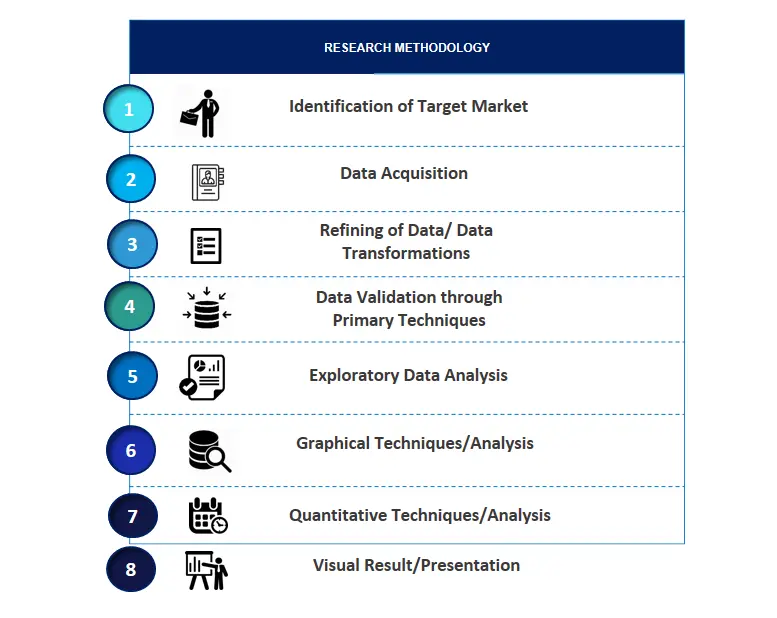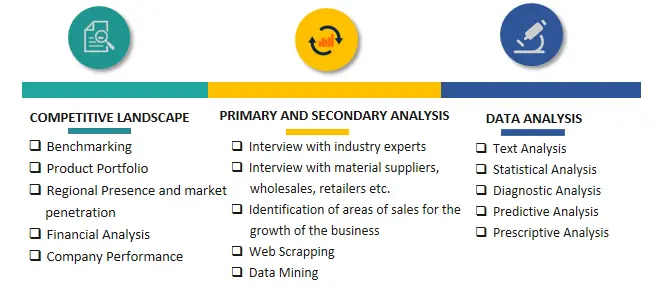
Industrial Fabric Cutting Machine Market Trends, Share, Size, Demand, Revenue and Future Outlook
Industrial Fabric Cutting Machine Market Growth, Size, Trends Analysis- By Type, By Application- Regional Outlook, Competitive Strategies and Segment Forecast to 2033
| Published: Dec-2024 | Report ID: MACH2444 | Pages: 1 - 247 | Formats*: |
| Category : Equipment and Machinery | |||
- In 2020, Gerber Technology introduced the Gerber Atria Digital Cutter, a device that can handle large-scale, mass manufacturing of knit and woven textiles.
- In 2021, Lectra unveiled the Vector iX6 fabric cutter, which is specifically made for cutting denim. To guarantee excellent cuts and avoid fabric distortion, the cutter makes use of a patented knife sharpening system, a high-performance vacuum system, and a clever knife cooling system.


| Report Metric | Details |
| Market size available for years | 2020-2033 |
| Base year considered | 2023 |
| Forecast period | 2024-2033 |
| Segments covered | By Type, By Application |
| Regions covered | North America, Asia-Pacific, Latin America, Middle East & Africa and Europe |
| Companies Covered | Aeronaut Automation, BRM Lasers, Calemard, Eastman Machine Company, KURIS Spezialmaschinen, Perfect Laser, REXEL, and SODIFA ESCA. |
- Textile and Apparel Manufacturers
- Upholstery and Furniture Manufacturers
- Automotive Manufacturers
- Medical Textile Manufacturers
- Sportswear and Technical Fabric Manufacturers
- Small and Medium-sized Enterprises (SMEs)
- Distributors and Suppliers of Cutting Machines
| By Type: | |
| By Application: |
- Global Industrial Fabric Cutting Machine Market Size (FY’2024-FY’2033)
- Overview of Global Industrial Fabric Cutting Machine Market
- Segmentation of Global Industrial Fabric Cutting Machine Market By Type (Semi-Automatic, Fully Automatic)
- Segmentation of Global Industrial Fabric Cutting Machine Market By Application (Garment, Textile, Others)
- Statistical Snap of Global Industrial Fabric Cutting Machine Market
- Expansion Analysis of Global Industrial Fabric Cutting Machine Market
- Problems and Obstacles in Global Industrial Fabric Cutting Machine Market
- Competitive Landscape in the Global Industrial Fabric Cutting Machine Market
- Impact of COVID-19 and Demonetization on Global Industrial Fabric Cutting Machine Market
- Details on Current Investment in Global Industrial Fabric Cutting Machine Market
- Competitive Analysis of Global Industrial Fabric Cutting Machine Market
- Prominent Players in the Global Industrial Fabric Cutting Machine Market
- SWOT Analysis of Global Industrial Fabric Cutting Machine Market
- Global Industrial Fabric Cutting Machine Market Future Outlook and Projections (FY’2024-FY’2033)
- Recommendations from Analyst
1.1. Scope of the report1.2. Market segment analysis
2.1. Research data source
2.1.1. Secondary Data2.1.2. Primary Data2.1.3. SPER’s internal database2.1.4. Premium insight from KOL’s2.2. Market size estimation2.2.1. Top-down and Bottom-up approach2.3. Data triangulation
4.1. Driver, Restraint, Opportunity and Challenges analysis4.1.1. Drivers4.1.2. Restraints4.1.3. Opportunities4.1.4. Challenges4.2. COVID-19 Impacts of the Global Industrial Fabric Cutting Machine Market.
5.1. SWOT Analysis5.1.1. Strengths5.1.2. Weaknesses5.1.3. Opportunities5.1.4. Threats5.2. PESTEL Analysis5.2.1. Political Landscape5.2.2. Economic Landscape5.2.3. Social Landscape5.2.4. Technological Landscape5.2.5. Environmental Landscape5.2.6. Legal Landscape5.3. PORTER’s Five Forces5.3.1. Bargaining power of suppliers5.3.2. Bargaining power of buyers5.3.3. Threat of Substitute5.3.4. Threat of new entrant5.3.5. Competitive rivalry5.4. Heat Map Analysis
6.1. Global Industrial Fabric Cutting Machine Market Manufacturing Base Distribution, Sales Area, Product Type6.2. Mergers & Acquisitions, Partnerships, Product Launch, and Collaboration in Global Industrial Fabric Cutting Machine Market
7.1. Global Industrial Fabric Cutting Machine Market Size, Share and Forecast, By Type, 2020-20267.2. Global Industrial Fabric Cutting Machine Market Size, Share and Forecast, By Type, 2027-20337.3. Semi-Automatic7.4. Fully Automatic
8.1. Global Industrial Fabric Cutting Machine Market Size, Share and Forecast, By Application, 2020-20268.2. Global Industrial Fabric Cutting Machine Market Size, Share and Forecast, By Application, 2027-20338.3. Garment8.4. Textile8.5. Others
9.1. Global Industrial Fabric Cutting Machine Market Size and Market Share
10.1. Global Industrial Fabric Cutting Machine Market Size and Market Share By Region (2020-2026)10.2. Global Industrial Fabric Cutting Machine Market Size and Market Share By Region (2027-2033)10.3. Asia-Pacific10.3.1. Australia10.3.2. China10.3.3. India10.3.4. Japan10.3.5. South Korea10.3.6. Rest of Asia-Pacific10.4. Europe10.4.1. France10.4.2. Germany10.4.3. Italy10.4.4. Spain10.4.5. United Kingdom10.4.6. Rest of Europe10.5. Middle East and Africa10.5.1. Kingdom of Saudi Arabia10.5.2. United Arab Emirates10.5.3. Qatar10.5.4. South Africa10.5.5. Egypt10.5.6. Morocco10.5.7. Nigeria10.5.8. Rest of Middle-East and Africa10.6. North America10.6.1. Canada10.6.2. Mexico10.6.3. United States10.7. Latin America10.7.1. Argentina10.7.2. Brazil10.7.3. Rest of Latin America
11.1. Aeronaut Automation,11.1.1. Company details11.1.2. Financial outlook11.1.3. Product summary11.1.4. Recent developments11.2. BRM Lasers11.2.1. Company details11.2.2. Financial outlook11.2.3. Product summary11.2.4. Recent developments11.3. Calemard11.3.1. Company details11.3.2. Financial outlook11.3.3. Product summary11.3.4. Recent developments11.4. Eastman Machine Company11.4.1. Company details11.4.2. Financial outlook11.4.3. Product summary11.4.4. Recent developments11.5. KURIS Spezialmaschinen11.5.1. Company details11.5.2. Financial outlook11.5.3. Product summary11.5.4. Recent developments11.6. Perfect Laser11.6.1. Company details11.6.2. Financial outlook11.6.3. Product summary11.6.4. Recent developments11.7. REXEL11.7.1. Company details11.7.2. Financial outlook11.7.3. Product summary11.7.4. Recent developments11.8. SODIFA ESCA11.8.1. Company details11.8.2. Financial outlook11.8.3. Product summary11.8.4. Recent developments11.9. Others
SPER Market Research’s methodology uses great emphasis on primary research to ensure that the market intelligence insights are up to date, reliable and accurate. Primary interviews are done with players involved in each phase of a supply chain to analyze the market forecasting. The secondary research method is used to help you fully understand how the future markets and the spending patterns look likes.
The report is based on in-depth qualitative and quantitative analysis of the Product Market. The quantitative analysis involves the application of various projection and sampling techniques. The qualitative analysis involves primary interviews, surveys, and vendor briefings. The data gathered as a result of these processes are validated through experts opinion. Our research methodology entails an ideal mixture of primary and secondary initiatives.



Frequently Asked Questions About This Report
PLACE AN ORDER
Year End Discount
Sample Report
Pre-Purchase Inquiry
NEED CUSTOMIZATION?
Request CustomizationCALL OR EMAIL US
100% Secure Payment






Related Reports
Our Global Clients
Our data-driven insights have influenced the strategy of 200+ reputed companies across the globe.




















